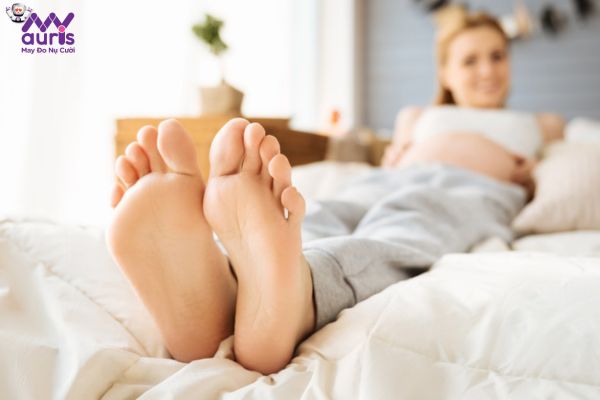Pregnancy is a magical time, but it is also full of turmoil for pregnant mothers. Typical changes in the body such as leg swelling can make the mother feel quite uncomfortable and experience many inconveniences in daily activities. So in reality, should pregnant women with swollen feet walk? Through this article, My Auris will synthesize and provide you with the most accurate answer.
Should pregnant women with swollen feet walk?
However, leg swelling is a fairly common physiological phenomenon during pregnancy. But many people are still confused and worried about this phenomenon. At the same time, it causes discomfort and inconvenience in daily life. Therefore, should pregnant women with swollen feet walk?

According to experts, pregnant women should still walk when they have swollen feet. This walking can bring many great benefits such as improving the ability to exercise, the body is supple in the joints, knees, ankles, helping maintain weight, reducing blood pressure, and improving the sleep of pregnant mothers, etc. Spending at least about 10 to 15 minutes a day to walk will help improve health and effectively support leg swelling.
On the other hand, mothers should not sit or stand for too long but should walk regularly to help blood circulate evenly in both legs. From the 4th month of pregnancy onwards, besides walking, the mother can choose to practice yoga to help prevent back pain, or uncomfortable shoulder and neck pain.
In what month will pregnant mothers usually experience leg swelling?
Leg edema is a common condition in pregnant mothers. It can appear at any time during pregnancy, but is most common in the last 3 months of pregnancy. This is the reason why doctors always advise pregnant women with swollen feet to walk every day, because walking will help reduce the condition effectively.

Specifically, leg edema occurs when fluid escapes into the interstitial space, causing fluid stagnation in the subcutaneous organizations. This stagnant fluid is mainly water, sometimes accompanied by an accumulation of protein or protein-rich fluids, if the mother has an infection or lymphatic obstruction.
Some typical signs of leg edema. that pregnant mothers can recognize:
- Edema is most obvious at the ankle down to the foot, with signs of swollen legs and flat ankles.
- Press on the swollen area and the skin will appear concave.
- The swollen leg area will be lighter in color than other parts of the body.
- Decreased urine output.
- The mother’s weight may increase steadily each day.
Phew Legs during pregnancy can occur in 8/10 mothers. Besides the legs, this swelling can also appear in other places on the body such as the arms, hands, or even on the face. When edema occurs, the mother needs to proactively consult a doctor to clarify the cause and take timely measures to avoid causing health risks.
Why are pregnant mothers susceptible to leg swelling?
During pregnancy, leg swelling is a very normal physiological phenomenon. Depending on the size of the fetus, the location or the body of each person, it can appear early or late late, more or less, severe or mild also depends on it. Whether pregnant women with leg swelling should walk or not, this is an effective way to improve the condition and should be taken care of every day.

Typical causes of this phenomenon include:
- During pregnancy, the mother’s body will produce more blood and fluids. Therefore, the body will need more blood to transport oxygen and nutrients to the baby in the womb.
- In the last 3 months of pregnancy, the phenomenon of leg swelling will be more common, because the weight of the fetus is getting bigger, taking up a large volume in the abdomen, creating a pressureIncreased pressure on the inferior vena cava, making it difficult for blood to pump from the lower limbs to the heart. With greater pressure, more blood flows into the legs, causing swelling in the legs, mainly in the feet and ankles.
- Hormone changes make the blood vessel walls gradually become softer, making it difficult for the veins to pump blood from the lower limbs to the heart.
In addition to internal causes, daily lifestyle also contributes to the effect, such as the mother standing too long and wearing shoes. high heels, heavy work, diet high in salt, lack of potassium, etc.
Some points to note so mothers can reduce leg swelling
To ensure safety for both the mother and the baby in the womb, mothers need to have regular prenatal checkups according to appointments with the doctor, and perform urine and blood tests to evaluate the health of themselves and their baby. Monitor your blood pressure and notify your doctor if unusual signs appear.

To help pregnant mothers feel more comfortable during daily activities, in addition to whether pregnant women with swollen legs should walk or not, there are some following notes to help them mothers reduce leg swelling during pregnancy:
- Pay attention to building a healthy diet, limit eating salt-rich foods such as canned foods, limit the use of salt in the cooking process, etc. Adding potassium-rich foods such as bananas, salmon, spinach, etc. will support the mother’s health well.
- Drink plenty of water every day, limit drinks containing caffeine, because it has a diuretic effect, promotes urine excretion and makes the body more likely to retain fluid, which will lead to leg swelling occurring sooner.
- Sleep upright and keep your feet elevated.
- Choose suitable shoes and clothes to help bring comfort to the mother.
- You should walk regularly, start with slow exercises like walking for about 10 to 20 minutes during the day. Once you get used to it, you can gradually increase the time and number of walks per week. Note that mothers should not walk too hard.
Hope this information can help you understandShould pregnant women with swollen feet walk? Walking should still be done every day and within the time allowed. This will help the mother improve her health and improve leg swelling effectively. At the same time, it is necessary to increase scientific nutrition and periodically visit a specialist for the safest guidance and health checks.
Yen Nhi





